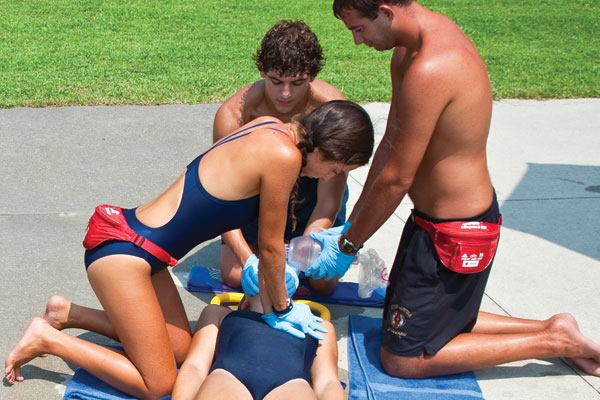The past 25 years have seen huge technological advances across most industries and lifeguarding is no exception. But most in the industry say that the biggest change involves training — both what’s being taught to prospective lifeguards and how that information’s being conveyed.
For decades, a lifeguard’s job was fairly simple: Monitor a rectangular pool or a stretch of beach. Now with the advent of waterparks with a variety slides and waves, the job has gotten more difficult. At the same time, there’s a higher demand for lifeguards. These two factors have required a radical change in how these professionals are taught to do their jobs.
“There is a direct correlation between lifeguards being properly trained and positioned and the reduction in drownings,” says Frank Pia, Ph.D., a long-time lifeguarding expert and a member of the American Red Cross scientific advisory council.
A first step to improving training was to get everyone on the same page. Historically, many lifeguard agencies acted individually and created their own approaches to lifesaving. However, over time an understanding grew that best practices do exist.
In recent years, most lifeguard training agencies have embraced blended learning, incorporating online components with the traditional classroom and in-pool sessions. The evolution of training also includes covering all needed skills — such as rescues, first aid and defibrillator use — in one curriculum, rather than spreading out the information among several courses.
In addition, it’s not enough for today’s guard to simply earn a certification. Now, most experts recommend frequent in-service training, especially when waterparks open new attractions. “If you are teaching the way you were 20 years ago, you’re missing out,” says Leslie Donavan, president of Starfish Aquatics Institute, an aquatic safety consulting agency based in Savannah, Ga.
It’s also important that those behind a desk, as well as those sitting in a tower, have a good understanding of lifeguarding technique. That’s why many agencies offer courses in lifeguard management. “There’s a clear correlation between lifeguard performance and the quality of their supervision,” says RAC Carroll, senior vice president and COO of Ellis & Associates, an aquatics safety agency.
The Red Cross began a lifeguard manager course as well. This gives supervisors basic lifesaving training, as well as information on managing staff, such as not requiring guards to perform cleaning or other duties while they’re supposed to be watching the water.
As training philosophies have evolved over the past quarter century, so has the equipment lifeguards use in their jobs. One of the most revolutionary pieces of equipment to come on the scene is also one of the most simple: the rescue tube. This innovation has changed the way those in distress are rescued.
Before the tube was regularly used, the lifeguard physically grabbed the victim and pulled them into safety. In some cases, a struggling victim could overwhelm the guard, putting them both in danger. Now, the guard keeps the rescue tube between them.
“The biggest milestone in lifeguarding was the switch from contact rescues to equipment-based rescues,” says Mike Espino, aquatics safety and risk specialist for the YMCA of the United States. “It’s better for the victim and the guard as well.” The tube now is virtually standard equipment.
That’s not to say that modern technology hasn’t left its mark on the industry. One thing that can have a positive effect on outcomes is the automatic electronic defibrillator. Most facilities have AEDs now and lifeguards are routinely trained in their use. Although they’re not a panacea, the use of such devices has been shown to aid revival of victims.
There is also technology that helps find swimmers in trouble. Systems can now link cameras arrayed throughout a facility to computers that analyze images from the pool to see if they fit the profile of a swimmer in distress. In that event, an alarm is sounded and a lifeguard is alerted to the situation.
While no replacement for guards, these technologies are good ancillary products.
There are also systems, used mostly in lakes or other “dark water” situations, where patrons wear a headband that sends an alert to lifeguard staff that its wearer has been submerged for a preset amount of time.
But there is one piece of technology that did more to raise the profile of lifeguards than any other advancement — the television camera. In 1989, “Baywatch” hit the small screen. The series, which lasted 12 years, was more soap opera than anything else. But its effect was felt across the profession.
“‘Baywatch’ reinforced many of the myths that people had about drowning victims,” Pia says. “And it stressed the fringe benefits of lifeguarding. They’re all parts of the job, but they can’t take the place of the primary task, which is prevention, followed by rescue. It hurt the image of lifeguards.”



